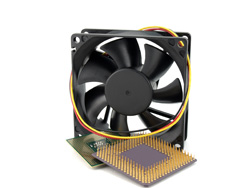Microprocessors need liquids to beat the heat
As current coolant technologies are approaching their technical limits, nanofluids have been reported to have superior thermal properties compared to conventional ones. Published reports of performance at the lab scale have suggested a more than 40 % improvement. However, the mechanisms are not clear. Scientists initiated the world's largest collaborative project, 'Enhanced nanofluid heat exchange' (NANOHEX)(opens in new window), for the research and development of nanofluid coolants to methodically explore this potential. Researchers focused on formulations for use in data centre cooling and traction power electronic cooling. Thermal tests of a variety of nanofluids enabled the population of a comprehensive database, the largest in existence, and the selection of two nanoparticle (NP) species for further development. Scientists prepared and optimised dispersions of silicon carbide (SiC) and aluminium oxide (Al2O3) in two different carrier fluids, water and water/ethylene glycol (EG). They demonstrated enhanced thermal conductivity between 10 and 20 % for the NPs dispersed in water/EG. Although lower than that expected based on published laboratory results, the enhancement is certainly promising. Investigators also found that the addition of NPs has important effects on viscosity, a consideration for future research. The team developed an assessment model to predict thermal performance of novel nanofluids using experimental data on viscosity and conductivity. Two demonstrator units were produced for each application and a life-cycle analysis and economic viability study were conducted. Results showed that a nanofluid-cooled data centre has important environmental benefits compared to conventional cooling. In addition, a simulation showed that water cooling could more than double the computing capacity of a data centre and nanofluids increased that by another 10 %, opening up important new markets for liquid coolant technology. Although nanofluid coolants do not affect the environmental impact of traction power electronics, they could significantly increase the operating lifetime of inverters. NANOHEX modelling and experimental results demonstrated a definite market for nanofluid coolants with particularly promising results in data centre cooling. In addition, the world's largest comprehensive database of nanofluid thermal properties together with simulation tools will be of tremendous importance in the continued development of high-performance and eco-friendly nanofluids for cooling applications.







